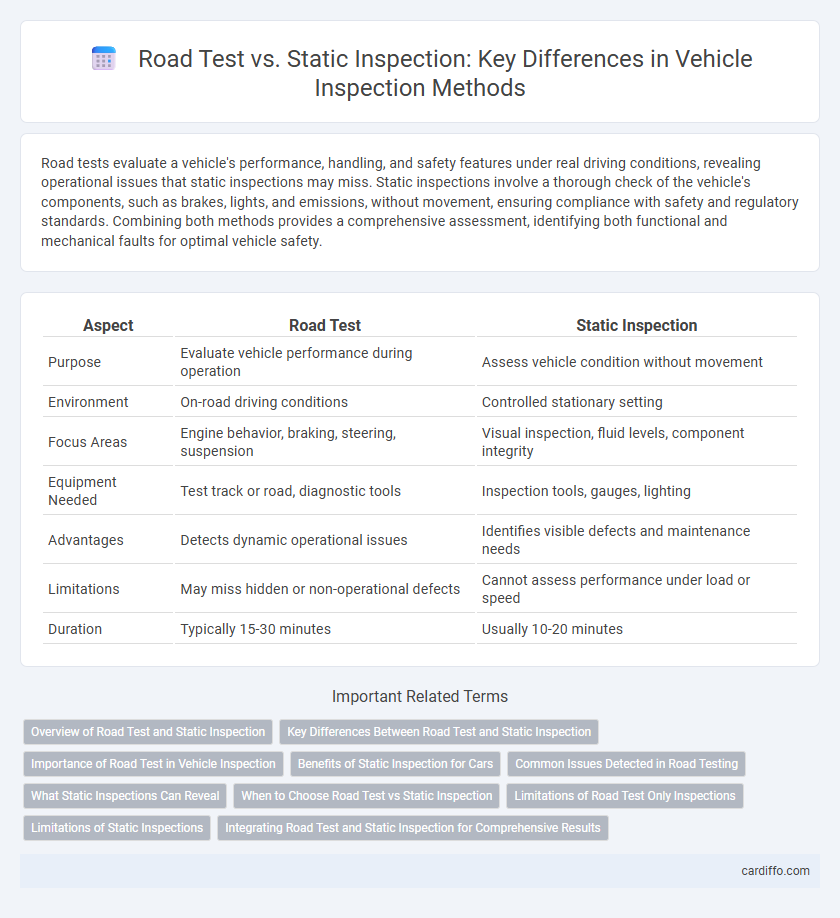Road tests evaluate a vehicle's performance, handling, and safety features under real driving conditions, revealing operational issues that static inspections may miss. Static inspections involve a thorough check of the vehicle's components, such as brakes, lights, and emissions, without movement, ensuring compliance with safety and regulatory standards. Combining both methods provides a comprehensive assessment, identifying both functional and mechanical faults for optimal vehicle safety.
Table of Comparison
| Aspect | Road Test | Static Inspection |
|---|---|---|
| Purpose | Evaluate vehicle performance during operation | Assess vehicle condition without movement |
| Environment | On-road driving conditions | Controlled stationary setting |
| Focus Areas | Engine behavior, braking, steering, suspension | Visual inspection, fluid levels, component integrity |
| Equipment Needed | Test track or road, diagnostic tools | Inspection tools, gauges, lighting |
| Advantages | Detects dynamic operational issues | Identifies visible defects and maintenance needs |
| Limitations | May miss hidden or non-operational defects | Cannot assess performance under load or speed |
| Duration | Typically 15-30 minutes | Usually 10-20 minutes |
Overview of Road Test and Static Inspection
Road test evaluates vehicle performance under real-world driving conditions, assessing engine function, braking efficiency, steering response, and suspension behavior. Static inspection involves a thorough, stationary examination of key components like tires, lights, emissions, and safety equipment to ensure compliance with regulatory standards. Both methods collectively enhance vehicle safety and reliability by identifying mechanical issues that might not be apparent through static checks alone.
Key Differences Between Road Test and Static Inspection
Road tests evaluate a vehicle's performance under real driving conditions, assessing factors like acceleration, braking, steering, and overall handling, while static inspections involve examining the vehicle's components and systems while it is stationary. Key differences include the dynamic assessment of operational functionality during road tests versus the thorough visual and mechanical checks of parts such as brakes, lights, emissions, and safety equipment during static inspections. Road tests identify issues related to driving performance, whereas static inspections focus on the condition and compliance of physical vehicle elements.
Importance of Road Test in Vehicle Inspection
Road tests play a crucial role in vehicle inspection by assessing real-world performance and identifying issues that static inspections might miss, such as drivability problems, transmission function, and brake response under load. They provide dynamic data on engine operation, steering, suspension, and emissions, ensuring the vehicle meets safety and environmental standards. Incorporating road tests enhances diagnostic accuracy and helps prevent potential failures that could compromise vehicle safety on the road.
Benefits of Static Inspection for Cars
Static inspection offers precise evaluation of a car's mechanical components, such as brakes, suspension, and engine systems, without the variability of road conditions. This method enables thorough diagnostics under controlled settings, enhancing accuracy and safety for identifying potential faults. Static inspection also reduces the risk of accidents and allows for early detection of issues that might not be apparent during a road test.
Common Issues Detected in Road Testing
Road testing commonly identifies issues such as engine performance problems, transmission malfunctions, and brake system inefficiencies that static inspections may overlook. It detects real-world operational faults including acceleration hesitation, unusual vibrations, and steering responsiveness. This dynamic evaluation ensures vehicles meet safety and functional standards under actual driving conditions.
What Static Inspections Can Reveal
Static inspections can reveal critical mechanical issues such as worn brake pads, fluid leaks, tire degradation, and faulty suspension components that are not always apparent during road tests. These inspections allow for detailed diagnostics of engine components, electrical systems, and structural integrity, detecting hidden defects before they impact vehicle safety. By thoroughly assessing systems under controlled conditions, static inspections help prevent breakdowns and ensure compliance with safety regulations.
When to Choose Road Test vs Static Inspection
Choose a road test when evaluating vehicle performance under real-world driving conditions, such as assessing engine power, transmission behavior, braking efficiency, and suspension response. Opt for static inspection for detailed assessment of components like engine compartment, fluid levels, and electrical systems without movement, making it ideal for diagnosing issues not apparent during driving. Road tests provide dynamic insight, whereas static inspections excel in comprehensive, stationary system evaluation.
Limitations of Road Test Only Inspections
Road test only inspections fail to identify hidden mechanical issues that manifest under specific conditions not encountered during a typical test drive, such as electrical faults or emissions problems. These inspections cannot detect safety-critical components like brake pad wear or tire tread depth without a physical examination. Relying solely on road tests increases the risk of overlooking defects that compromise vehicle safety and regulatory compliance.
Limitations of Static Inspections
Static inspections fail to identify dynamic vehicle behaviors such as handling, braking efficiency, and real-time engine performance under load, which are critical for ensuring roadworthiness. They cannot detect issues arising only during motion, like transmission problems or suspension irregularities, limiting their effectiveness in comprehensive vehicle assessment. Consequently, road tests remain essential to uncover latent faults that static inspections overlook.
Integrating Road Test and Static Inspection for Comprehensive Results
Integrating road test and static inspection techniques enhances vehicle evaluation accuracy by combining dynamic performance data with detailed mechanical and system status analysis. Road tests capture real-world driving conditions to assess engine response, braking efficiency, and suspension behavior, while static inspections identify potential safety hazards and faults through thorough component checks. Utilizing both methods provides a comprehensive overview of vehicle safety, reliability, and regulatory compliance, optimizing maintenance and repair decisions.
Road test vs static inspection Infographic

 cardiffo.com
cardiffo.com